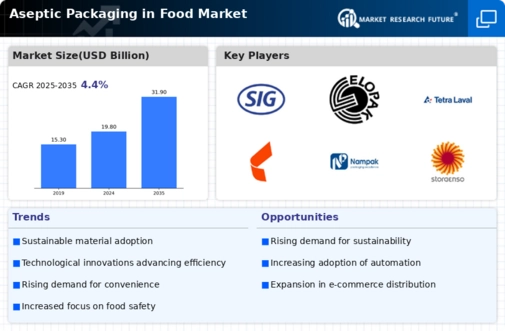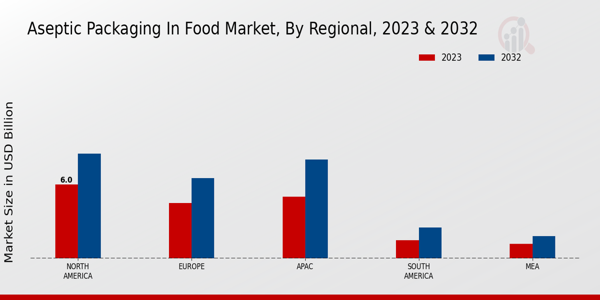Market Growth Projections
The Global Aseptic Packaging in Food Market Industry is poised for substantial growth, with projections indicating a rise from 19.8 USD Billion in 2024 to 31.9 USD Billion by 2035. This growth trajectory reflects a compound annual growth rate (CAGR) of 4.41% from 2025 to 2035. Factors such as increasing consumer demand for convenience foods, sustainability initiatives, and technological advancements are likely to drive this expansion. The market's ability to adapt to changing consumer preferences and industry trends positions it favorably for future growth, making it a key area of interest for stakeholders in the food packaging sector.
Sustainability Initiatives
Sustainability emerges as a pivotal driver in the Global Aseptic Packaging in Food Market Industry. With growing environmental concerns, consumers and manufacturers alike prioritize eco-friendly packaging solutions. Aseptic packaging, often made from recyclable materials, aligns with these sustainability goals. Companies are increasingly investing in sustainable practices, which not only enhance brand image but also cater to environmentally conscious consumers. This shift is likely to contribute to the market's growth, as the industry adapts to meet the demand for sustainable packaging solutions. The anticipated growth from 19.8 USD Billion in 2024 to 31.9 USD Billion by 2035 underscores the importance of sustainability in shaping market dynamics.
Technological Advancements
Technological advancements play a crucial role in shaping the Global Aseptic Packaging in Food Market Industry. Innovations in packaging materials and processes enhance the efficiency and effectiveness of aseptic packaging. For instance, advancements in barrier technologies improve the shelf life and safety of packaged foods. Moreover, the integration of automation and smart technologies streamlines production processes, reducing costs and increasing output. As a result, manufacturers are more inclined to adopt aseptic packaging solutions, contributing to the industry's growth. The projected CAGR of 4.41% from 2025 to 2035 indicates that technological progress will continue to drive market expansion.
Growing Health Consciousness
The Global Aseptic Packaging in Food Market Industry is influenced by a rising awareness of health and wellness among consumers. As individuals become more health-conscious, there is an increasing demand for nutritious and minimally processed food options. Aseptic packaging allows for the preservation of essential nutrients without the need for preservatives, appealing to health-oriented consumers. This trend is evident in the growing popularity of organic and natural food products, which often utilize aseptic packaging to maintain quality. The industry's adaptability to health trends positions it favorably for continued growth, aligning with consumer preferences for healthier food choices.
Expansion of E-commerce Channels
The expansion of e-commerce channels significantly impacts the Global Aseptic Packaging in Food Market Industry. As online grocery shopping becomes more prevalent, the demand for packaging solutions that ensure product safety and quality during transit increases. Aseptic packaging, with its ability to maintain food integrity without refrigeration, is particularly suited for e-commerce applications. This trend is likely to drive market growth as more consumers opt for online purchases. The industry's response to the e-commerce boom may further enhance its market value, contributing to the anticipated increase from 19.8 USD Billion in 2024 to 31.9 USD Billion by 2035.
Rising Demand for Convenience Foods
The Global Aseptic Packaging in Food Market Industry experiences a notable surge in demand for convenience foods, driven by changing consumer lifestyles. As urbanization accelerates, consumers increasingly seek ready-to-eat and easy-to-prepare food options. Aseptic packaging provides a solution by extending shelf life without refrigeration, making it ideal for busy households. This trend is reflected in the projected market value of 19.8 USD Billion in 2024, indicating a robust growth trajectory. The convenience factor not only appeals to consumers but also encourages manufacturers to adopt aseptic packaging technologies to meet evolving preferences.













